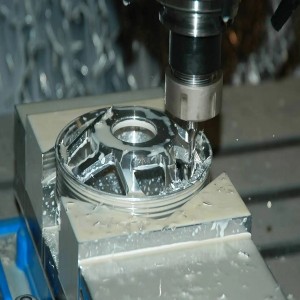Humans produce hundreds of millions of plastic products every year. This adaptable material can be formed into finished products by a variety of methods. Two popular methods are injection molding and CNC machining, but do you understand the different advantages of each?
This article will help you to understand the ideal applications for injection molding and CNC machining.
What is CNC Machining?
As we’ve covered in other articles, CNC machining actually encompasses a collection ofdifferent equipment and processes. Within CNC machining, there are milling machines (pictured above), lathes, drills, and an assortment of cutting processes. What ties these processes together is the use of computer numerical controlled (CNC) tooling to selectively remove material from a workpiece until it fits the design of a finished product.
Traditional CNC machining processes are effective for fabricating products from an impressively wide range of materials, including numerous plastic compounds. By cutting, turning, drilling, and vaporizing small segments of plastic workpieces, CNC machines can carve out high-quality, precision-made products.
What is Injection Molding?
If CNC machining is like carefully chiseling away to create a statue, injection molding is more like casting a statue by pouring a liquid material into a mold and letting it solidify. Actually, it’s probably more like casting several statues at the same time over and over again. Injection molding is most commonly used for the high-volume production of plastic goods and can produce thousands or even millions of copies of a unit.
Injection molding machines use pressurized equipment to force liquid material, typically some kind of molten thermoplastic or thermoset polymer, into a metal mold made from two or more parts. The plastic quickly cools and solidifies, allowing the mold to be opened so that the solid plastic parts can be ejected.
Injection Molding vs CNC Machining: 4 Key Differences
While these two manufacturing processes are both great for producing various plastic consumer goods, their respective strengths and limitations make them better suited for some applications over others.
1) Production Volumes, Costs, & Times
While both processes can be used to produce large volumes of plastic products, they have very different restrictions. CNC machining is fast to implement and can rapidly prototyperapidly prototype a new part within a day if the material is on hand. CNC machines can also be set up to produce larger volumes of parts over an extended period of time, but the price is relatively unchanged, meaning high production volumes have higher costs.
Injection molding on the other hand is only efficient for rapid prototyping if you have a smaller machine. In most cases, injection molding is best used for very large production volumes with thousands of units. This helps to justify the cost of custom molds and expensive equipment. And while it takes an extended lead time to develop the custom molds, they can produce a batch of parts in seconds once they are up and running. This means injection molding benefits substantially from economies of scale.
2) Design Flexibility
Another consideration for designers should be whether small changes are expected to the part design or if it will remain completely unrevised during production. CNC machining is highly adaptable, so if additional features need to be included after producing several units, the CNC CAD file can be updated and subsequent units will reflect the change without interruption. If the same thing were to happen with injection molding, however, a new mold would most likely need to be procured, adding cost and delaying production.
There could also be some limitations on part size. While injection molding is best suited to medium-to-small sized parts, CNC machining can adapt to meet a range of requirements, including extra large sizes.
3) Materials Options
When considering material options for parts, CNC machining can easily accommodate an extremely wide range of materials. Injection molding can also grow on a growing body of materials options, but it does have more limitations.
One unique consideration however is based on the hardness of the material. Hard plastics are ideal for CNC machining as they do not easily deform or gall, so they form nice chips and meet tolerances well. On the other hand, very soft materials are difficult to machine with precision, deforming, and flexing as a result of the cutting forces. Injection molding may not have these issues as long as the plastic does not get stuck in the mold.
4) Finished Part Quality
While high-quality injection molding machines can produce good quality parts, they can seldom achieve the same tolerances or surface finish quality as CNC machining processes. Additionally, the potential for voids to form inside larger injection molded parts makes them weaker and prone to unpredictable failures when put under stress. The fact is, however, that for many of the popular plastic products we use in our daily lives, the quality produced by injection molding is more than satisfactory.
We offer decades of experienced professionals and state-of-the-art equipment to help you meet your manufacturing needs, with professional CNC machining services you can rely on!
Post time: Mar-14-2023







